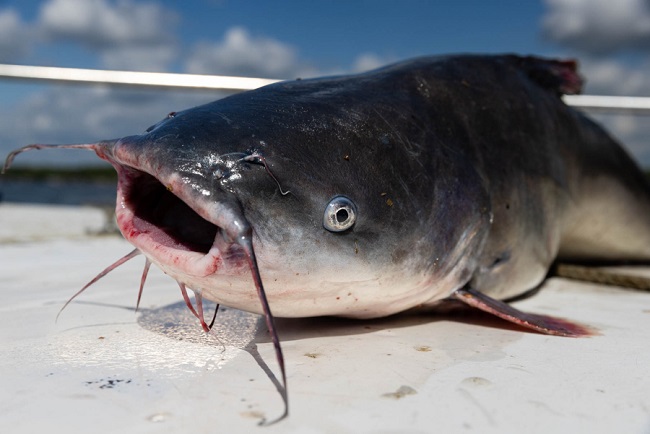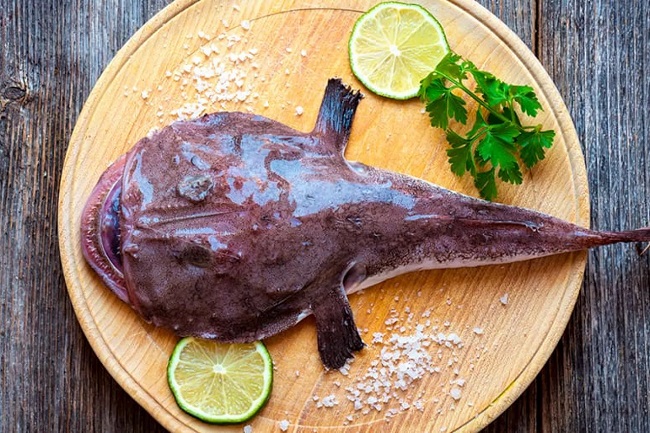Fish are a vital part of the global diet, offering a rich source of nutrients, including omega-3 fatty acids, proteins, and essential vitamins.
Here, we explore the top 30 types of fish that humans can eat, highlighting their nutritional benefits, culinary uses, and sustainability.
Exploring the World of Seafood: Top 30 Types of Fish That Humans Can Eat
1. Salmon
Salmon is one of the most popular and nutritious types of fish consumed worldwide. Known for its rich, oily flesh and distinctive pink color, salmon is packed with omega-3 fatty acids, proteins, and vitamins D and B12.

There are various species, including Atlantic, Chinook, and Sockeye. Salmon is versatile in the kitchen, suitable for grilling, baking, smoking, and raw preparations like sushi and sashimi. Sustainable farming practices and wild-caught certifications help ensure a responsible choice.
2. Tuna
Tuna, especially varieties like Yellowfin, Bluefin, and Albacore, is a favorite among seafood lovers. Rich in protein and omega-3 fatty acids, tuna is known for its firm texture and mild flavor. It is commonly used in sushi, sashimi, grilling, and canning. Opting for sustainably caught tuna, such as those certified by the Marine Stewardship Council (MSC), helps protect ocean ecosystems and fish populations.
3. Cod
Cod, known for its mild flavor and flaky white flesh, is a staple in many diets. It is a great source of lean protein, vitamins B6 and B12, and omega-3 fatty acids. Cod is versatile and can be baked, grilled, poached, or fried. Popular dishes include fish and chips and cod fillets. Look for Atlantic cod from sustainable sources or Pacific cod to support responsible fishing practices.
4. Halibut
Halibut is a flatfish known for its firm, white flesh and mild flavor. It is rich in protein, selenium, and omega-3 fatty acids. Halibut is suitable for grilling, baking, and pan-searing. Due to concerns about overfishing, it is essential to choose halibut from sustainably managed fisheries, such as those certified by MSC.
5. Mackerel
Mackerel is an oily fish known for its strong flavor and high omega-3 fatty acid content. It is also rich in vitamin D, selenium, and B vitamins. Mackerel can be grilled, smoked, or pickled and is often enjoyed in Mediterranean and Asian cuisines. Sustainable choices include Atlantic mackerel and Pacific chub mackerel, which are abundant and responsibly fished.
6. Sardines
Sardines are small, oily fish packed with omega-3 fatty acids, calcium, and vitamin D. They are commonly canned but can also be grilled, smoked, or added to salads and pastas. Sardines are among the most sustainable seafood options, as they are abundant and have a low impact on marine ecosystems.
7. Trout
Trout, particularly rainbow trout, is a freshwater fish known for its delicate flavor and tender flesh. It is rich in protein, omega-3 fatty acids, and vitamin B12. Trout can be baked, grilled, or pan-fried. Farmed trout, especially from certified sustainable sources, is a responsible choice to reduce pressure on wild populations.
8. Herring
Herring is an oily fish rich in omega-3 fatty acids, vitamin D, and selenium. It is commonly smoked, pickled, or salted and is a staple in Scandinavian and Eastern European cuisines. Herring is considered a sustainable choice due to its abundance and the use of responsible fishing methods.
9. Snapper
Snapper, particularly the red snapper, is a popular fish known for its firm texture and mild, sweet flavor. It is a good source of protein, vitamin A, and omega-3 fatty acids. Snapper is versatile and can be grilled, baked, or steamed. To support sustainability, choose snapper from well-managed fisheries or certified sources.
10. Tilapia
Tilapia is a mild-flavored, white-fleshed fish that is easy to cook and widely available. It is a good source of protein, niacin, and phosphorus. Tilapia can be baked, grilled, or fried and is often used in fish tacos and seafood stews. Opt for tilapia from responsibly managed farms, particularly those using eco-friendly practices.
11. Sea Bass
Sea Bass, particularly European Sea Bass and Chilean Sea Bass, is prized for its delicate flavor and firm, white flesh. It is rich in protein, omega-3 fatty acids, and selenium. Sea Bass is versatile in the kitchen, suitable for grilling, baking, and pan-searing. Opt for sustainably sourced Sea Bass, such as those certified by the Marine Stewardship Council (MSC), to ensure responsible fishing practices.
12. Barramundi
Barramundi, also known as Asian Sea Bass, is known for its mild flavor and flaky texture. It is a good source of omega-3 fatty acids, protein, and vitamin D. Barramundi can be grilled, baked, or fried and is popular in Australian and Southeast Asian cuisines. Choose sustainably farmed Barramundi to support eco-friendly aquaculture practices.
13. Swordfish
Swordfish is a large, meaty fish known for its firm texture and mildly sweet flavor. It is rich in protein, omega-3 fatty acids, and vitamin D. Swordfish is excellent for grilling and is often served as steaks. Due to concerns about overfishing, it is important to choose swordfish from sustainable sources or certified fisheries.
14. Grouper
Grouper is a popular fish known for its mild flavor and firm texture. It is a good source of protein, vitamins B6 and B12, and selenium. Grouper can be grilled, baked, or fried and is often featured in Mediterranean and Caribbean dishes. Sustainable choices include Black Grouper and Gag Grouper from responsibly managed fisheries.
15. Anchovies
Anchovies are small, oily fish known for their strong, savory flavor. They are packed with omega-3 fatty acids, calcium, and vitamin D. Anchovies are commonly used in sauces, salads, and pizzas, and can also be eaten fresh or canned. Anchovies are considered a sustainable seafood option due to their abundance and low environmental impact.
16. Flounder
Flounder is a mild-flavored, flatfish with delicate, white flesh. It is rich in protein, vitamin B12, and selenium. Flounder can be baked, sautéed, or fried and is often used in European and Asian cuisines. Look for flounder from well-managed fisheries to support sustainable practices.
17. Pollock
Pollock, particularly Alaska Pollock, is known for its mild flavor and flaky texture. It is a good source of protein, omega-3 fatty acids, and vitamin B12. Pollock is commonly used in fish sticks, fish and chips, and surimi (imitation crab meat). Alaska Pollock is considered a sustainable seafood choice due to its well-managed fishery.
18. Catfish

Catfish is a popular freshwater fish known for its mild, sweet flavor and firm texture. It is rich in protein, vitamin B12, and omega-3 fatty acids. Catfish can be grilled, fried, or baked and is often featured in Southern and Cajun cuisines. Choose farmed catfish from certified sustainable sources to support eco-friendly aquaculture.
19. Pompano
Pompano is a prized fish known for its delicate flavor and firm, white flesh. It is rich in protein, vitamin B12, and selenium. Pompano can be grilled, baked, or sautéed and is popular in Mediterranean and Asian cuisines. Ensure you select pompano from sustainable fisheries to support responsible fishing practices.
20. Mahi-Mahi
Mahi-Mahi, also known as Dolphinfish, is known for its sweet, mild flavor and firm texture. It is a good source of protein, omega-3 fatty acids, and vitamin B12. Mahi-Mahi is versatile in the kitchen and can be grilled, baked, or sautéed. Look for Mahi-Mahi from sustainable sources, such as those certified by MSC, to support ocean conservation.
21. Haddock
Haddock is a popular white fish known for its mild flavor and flaky texture. It is a good source of protein, vitamin B12, and selenium. Haddock is commonly used in fish and chips, baked, or grilled. Sustainable choices include haddock from well-managed fisheries in the North Atlantic.
22. Tilapia
Tilapia is a mild-flavored, white-fleshed fish that is easy to cook and widely available. It is a good source of protein, niacin, and phosphorus. Tilapia can be baked, grilled, or fried and is often used in fish tacos and seafood stews. Opt for tilapia from responsibly managed farms, particularly those using eco-friendly practices.
23. Arctic Char
Arctic Char is a cold-water fish related to salmon and trout, known for its mild flavor and pinkish flesh. It is rich in omega-3 fatty acids, protein, and vitamin D. Arctic Char can be grilled, baked, or smoked and is a sustainable alternative to salmon, as it is often farmed responsibly.
24. Snapper
Snapper, particularly the red snapper, is a popular fish known for its firm texture and mild, sweet flavor. It is a good source of protein, vitamin A, and omega-3 fatty acids. Snapper is versatile and can be grilled, baked, or steamed. To support sustainability, choose snapper from well-managed fisheries or certified sources.
25. Perch
Perch, including varieties like yellow perch and European perch, is known for its mild flavor and flaky white flesh. It is a good source of protein, vitamin B12, and omega-3 fatty acids. Perch can be baked, grilled, or fried and is often used in European and North American cuisines. Look for perch from sustainable sources to support responsible fishing practices.
26. Hake
Hake is a white fish with a mild flavor and firm texture, rich in protein, vitamin B12, and selenium. It is commonly used in European and South American cuisines, suitable for grilling, baking, and frying. Sustainable choices include hake from certified fisheries in the North Atlantic and South Pacific.
27. Walleye
Walleye, also known as yellow pike, is a freshwater fish known for its delicate flavor and firm, flaky flesh. It is rich in protein, vitamin B12, and omega-3 fatty acids. Walleye can be baked, grilled, or fried and is a favorite in North American cuisines, particularly in the Great Lakes region. Opt for walleye from sustainable fisheries to support eco-friendly practices.
28. Rockfish
Rockfish, including varieties like Pacific rockfish and Atlantic rockfish, is known for its mild flavor and firm texture. It is a good source of protein, vitamin B12, and selenium. Rockfish can be grilled, baked, or sautéed and is often used in seafood stews and chowders. Choose rockfish from sustainable sources to support responsible fishing practices.
29. Bluefish
Bluefish is known for its strong, rich flavor and firm texture. It is rich in omega-3 fatty acids, protein, and vitamin D. Bluefish can be grilled, baked, or smoked and is popular in Mediterranean and North American cuisines. Sustainable choices include bluefish from well-managed fisheries in the Atlantic.
30. Monkfish

Monkfish, often referred to as “poor man’s lobster” due to its sweet, firm flesh, is a versatile fish rich in protein, vitamin B12, and selenium. Monkfish can be grilled, baked, or sautéed and is often used in soups and stews. To support sustainability, choose monkfish from well-managed fisheries in the North Atlantic.
Conclusion
These top 30 types of fish offer a variety of flavors, textures, and nutritional benefits, making them excellent choices for a healthy diet. When selecting fish, consider sustainability and opt for species that are responsibly sourced to support marine conservation.
By making informed choices, you can enjoy delicious seafood while contributing to the health of our oceans and the future of fish populations.



